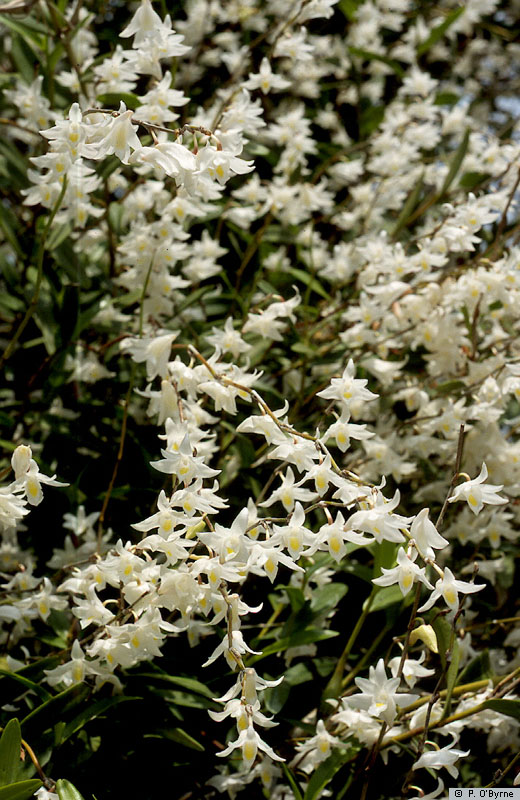
Common Name The Purse-Shaped Dendrobium - The Pigeon Orchid - The Bag-Shaped Dendrobium [refers to the saccate mentum]
Flower Size 2" or less [5 cm or less]
Commonly called the pigeon orchid, it is found in Chinese Himalayas, Taiwan, India, Sri Lankha, Andaman Islands, Myanamar, Thailand, Malaysia, Cambodia, Laos, Vietnam, Lesser Sunda Islands, Moluccas,Sulawesi, Sumatra, New Guinea, Christmas Islands and the Philippines in semi-deciduous and deciduous dry lowland forests and savana-like woodlands at an altitude of sealevel to 500 meters and grows small to large sized, warm to hot, best mounted on wood with spindle shaped, swollen basally for a few nodes, ridged, yellow with age stems that can branch, carrying, 4 to 19, thick, leathery, eventually deciduous leaves that will flower on the upper nodes of the leafless older canes with several to many fragrant flowers, albeit for only a few hours, after a temperature drop and rain. It has a tendency to keiki and when there are 2 small pseudobulbs and a third starting they can be broken away from the old pseudobulb and mounted to a small branch. Thsi species is often found in conjunction with ants and may benefit from their presence.
In Malacca, a state within Penninsular Malaysia the pounded leaves are applied to pimples and boils as a curative.
In Java the fruits of this species along with fruits [not necassarily all together] from Plocoglottis javanica, Bulbophyllum vaginatum and Hippeophyllum scortechnii; are boiled and the juice is applied into ones ears for an earache
Also in Java the flowers are ground to make a material to use for those with cholera.
Synonyms *Angraecum crumenatum Rhump.; Aporum crumenatum (Sw.) Brieger 1981; Aporum ephemerum (J.J.Sm.) Rauschert 1983; Aporum kwashotense (Hayata) Rauschert 1983; Aporum papilioniferum (J.J.Sm.) Rauschert 1983; Aporum scalpelliforme (Teijsm. & Binn.) Rauschert 1983; Callista crumenatum [Sw.] O.Ktze. 1891; Ceraia ephemera (J.J.Sm.) M.A.Clem. 2003; Ceraia papilionifera (J.J.Sm.) M.A.Clem. 2003; Ceraia parviflora (Ames & C.Schweinf.) M.A.Clem. 2003; Ceraia simplicissima Lour. 1791; Dendrobium caninum Merr. 1921; Dendrobium ceraia Lindley 1830; Dendrobium coninum Sw. ?; Dendrobium crumenatum var. parviflora Ames & C.Schweinf. in ?; Dendrobium cumulatum Krzl not Lindley ?; Dendrobium ephemerum (J.J.Sm.) J.J.Sm. in E.D.Merrill 1917; Dendrobium kwashotense Hayata 1914; Dendrobium papilioniferum J.J.Sm. 1905; Dendrobium papilioniferum var. ephemerum J.J.Sm 1905; Dendrobium schmidtianum Krzl. 1902; Dendrobium simplicissimum [Loureiro]Kraenzlin 1910; Epidendrum caninum Burm. f. 1768; Epidendrum ceraia Raeusch. 1797; Onychium crumenatum [Sw] Blume 1825
References W3 Tropicos, Kew Monocot list , IPNI ; Orchids of Burma Grant 1895/1995; Die Orchideen Von Java J.J.Sm. 1905; AOS Bulletin Vol 28 No 4 1959; The Orchids of Thailand Seidenfaden & Smitinand 1959 drawing as D schmidtianum; The Orchids of Thailand Seidenfaden & Smitinand 1959 drawing photo fide; Orquideologia Vol 12 3/4 1977/8; AOS Bulletin Vol 47 No 6 1978; Orchid Digest Vol 42 No 5 1978 photo; AOS Bulletin Vol 48 No 3 1979 photo; Orchids of Java Comber 1990; A Checklist of the Orchids of Borneo Wood & Cribb 1994; Orchid Australia Vol 12 No 1 2000 photo; Orchids of Sumatra Comber 2001; The Orchids of the Philippines Cootes 2001; Lindleyana Vol 17 No 1 2002; Lindleyana Vol 17 No 1 2002 as D ephemerum; Flora Malesiana Orchids of the Philippines Vol I Agoo, Shuiteman and de Vogel 2003; AOS Bulletin Vol 73 No 8 2004; The Dendrobiums H. P. Wood 2006
Tidak ada komentar:
Posting Komentar